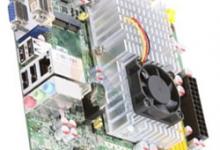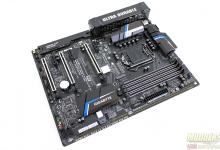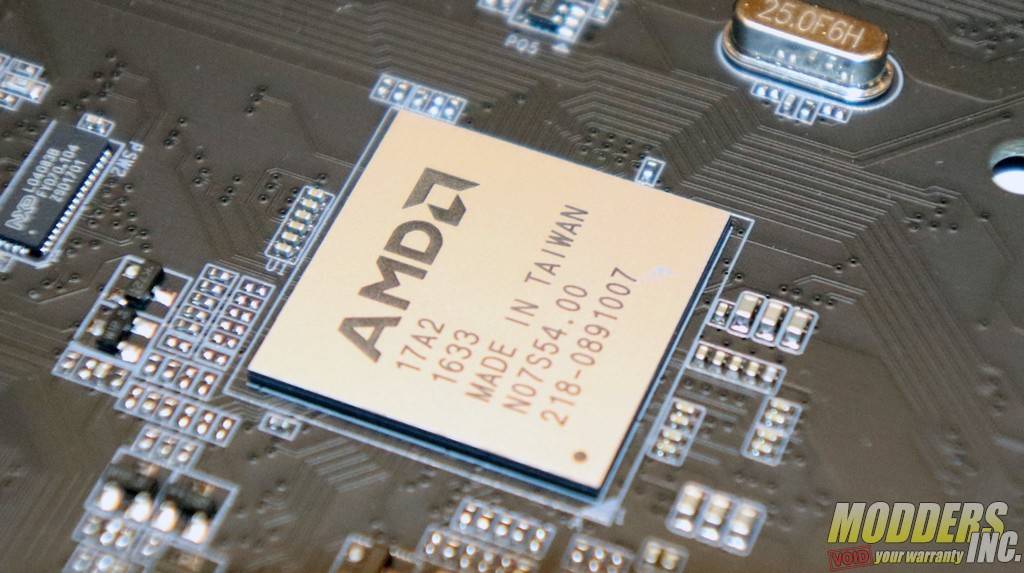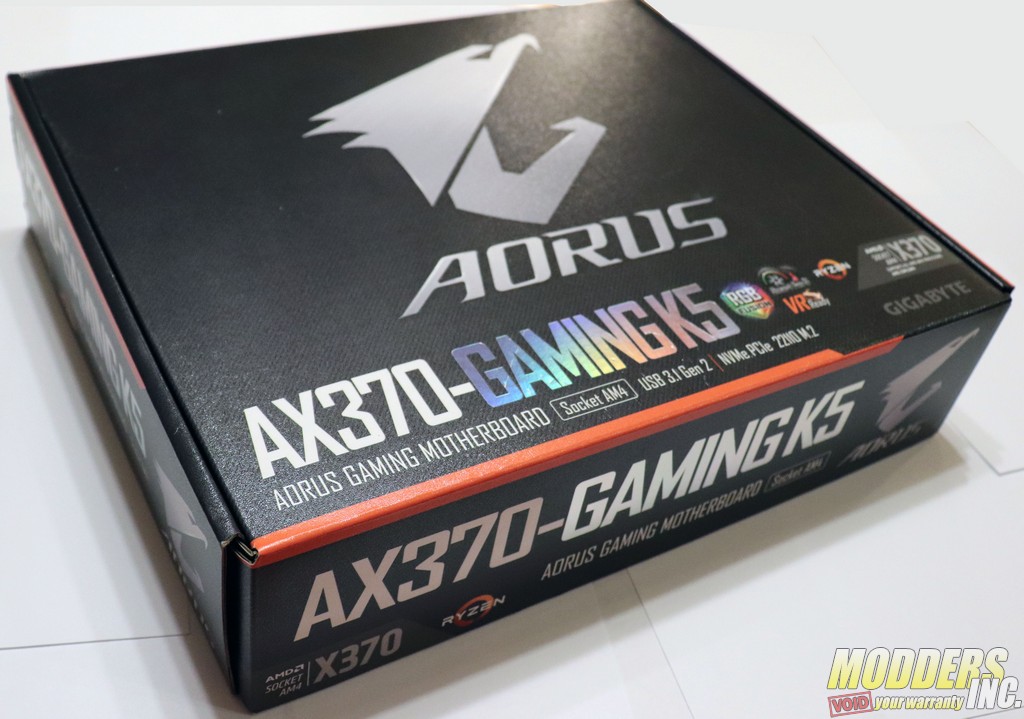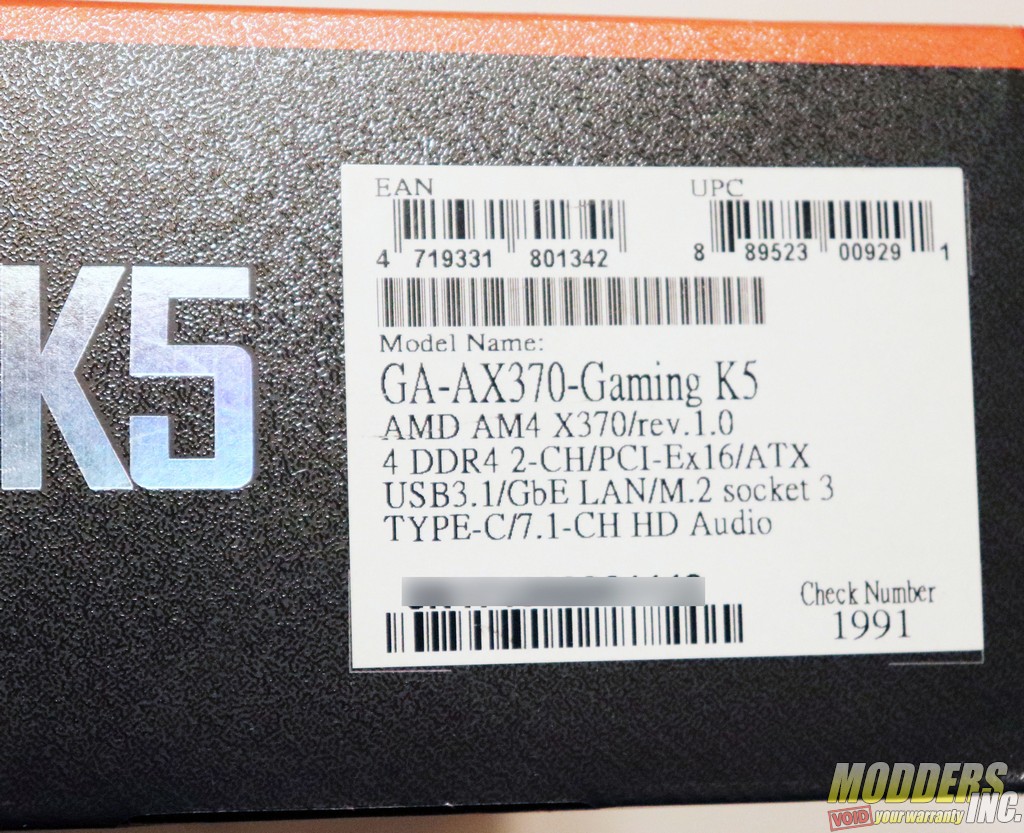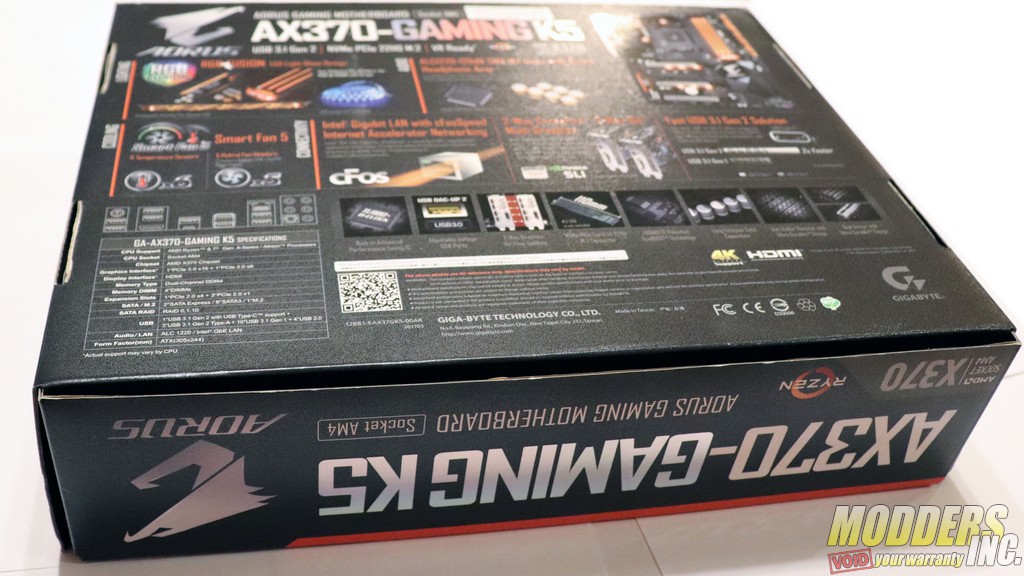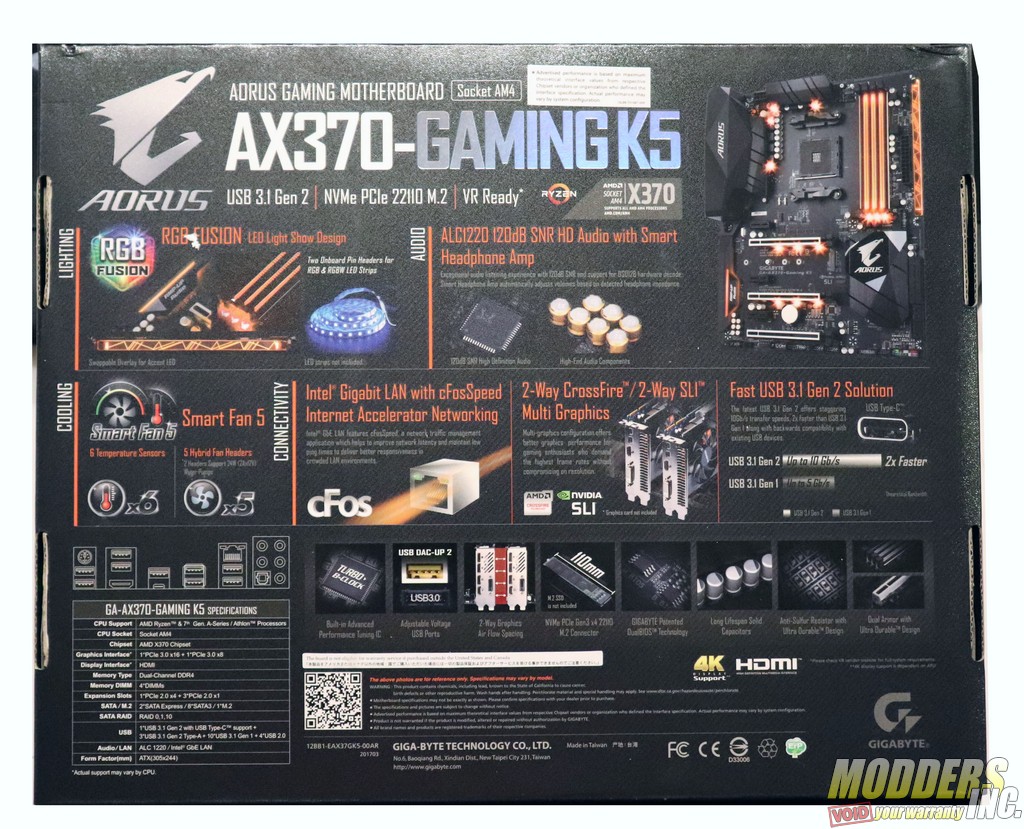Gigabyte has released a number of X370 motherboards to support AMD’s Ryzen processors, and one of the early boards to see a release was the AORUS AX370-Gaming K5. As of this writing, this ATX motherboard has a BIOS (Version F23d) that makes it a viable option for any AM4-based processor, including Bristol Ridge (Excavator), Summit Ridge (Zen), Raven Ridge (Zen APUs), and AMD’s upcoming Pinnacle Ridge (Zen+) processors.
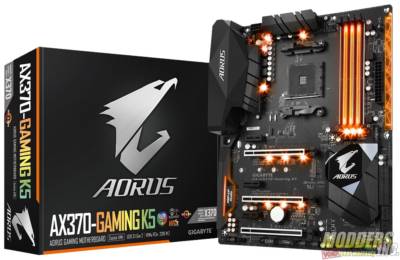
If Gigabyte’s naming scheme has you scratching your head, you’re not alone. This motherboard is similar to the
AORUS AX370-Gaming 5, but it lacks the dual Ethernet ports (the Killer
E2500 NIC is the one not found on our board), there are fewer USB 3.1 ports, and slightly fewer memory and CPU overclocking options. A close look at the VRM also reveals that the K5 version we’re looking at here has a less robust voltage regulation subsystem, but these relatively minor sacrifices get you an X370 motherboard with a solid feature set for roughly $30 less than the Gigabyte AX370-Gaming 5. The big thing this board has going for it compared to the Gaming 5 is the all-black shrouds, which look much more at home on the all-black PCB. To see if this board will make a worthy platform for your next AMD-based system, read on.
Review Sample Provided by: Gigabyte
Product given in exchange for work done to produce this review.
Under The Hood
For gamers and enthusiasts looking to build an AMD-based PC, there are really only two chipsets to choose from, and this motherboard comes with the more feature-complete of the two. Compared to the B350 chipset, X370 can take the PCIe x16 graphics interface and split it into dual PCIe 3.0 x8 slots for SLI or CrossFire. AM4 motherboards that support a third graphics card are few and far between, but these utilize a PCIe 2.0 x4 interface.
The chipset in the AORUS AX370-Gaming K5 has native support for up to two more PCIe 2.0 slots (up to 8 total), four more USB 3.0 ports (up to six total), and two more 6Gbps SATA ports (up to six total). Features the two chipsets share include up to two USB 3.1 ports, up to six USB 2.0 ports, and support for RAID 0, 1, and 10. Keep in mind, RAID support on AM4 is limited to SATA devices. If you want AMD’s NVMe RAID support, you’ll need to look to the Ryzen Threadripper platform. It’s important to point out that although a chipset supports the various links mentioned above, it’s up to the motherboard manufacturer to install the physical ports and slots associated with those features.
Every AMD Ryzen processor features an unlocked multiplier, which is a must for anyone who’s looking to eke out a bit more performance from the processor compared to its stock settings. As such, both the X370 and B350 chipsets have overclocking support. That being said, the options you find in the UEFI menu will vary between manufacturer and model.
AMD’s Ryzen processors feature integrated dual-channel DDR4 memory controllers and native support for DDR4-2667, though motherboards like this one can handle overclocked memory, using the board’s built-in MP profiles, up to Ryzen’s practical ceiling of DDR4-3200. This speed is the upper limit for two modules, but if you want to install four modules, don’t expect to be able to run it faster than 2,667MHz. There’s also up to 16 PCIe 3.0 lanes for graphics hardware. This motherboard, and many other AM4 boards on the market support both A-series APUs and Raven Ridge (Zen-based) APUs, which is why there are usually one or more display outputs on the rear I/O. (This motherboard features an HDMI port.) NVMe storage devices can tap into the processor’s four dedicated PCIe x4 lanes for up to 32Gbps of bandwidth on NVMe and SATA SSDs.
Specifications
|
CPU |
AM4 Socket:
1. AMD Ryzen™ processor 2. AMD 7th Generation A-series/ Athlon™ processor (Please refer “CPU Support List” for more information.) |
| Socket | Socket AM4 |
| Chipset | 1. AMD X370 |
| Memory | 1. 4 x DDR4 DIMM sockets supporting up to 64 GB of system memory
2. Dual channel memory architecture 3. Support for DDR4 3200(O.C.) / 2933(O.C.) / 2667* / 2400 / 2133 MHz memory modules * Support for higher than DDR4 2667 MHz may vary by CPU. 4. Support for ECC Un-buffered DIMM 1Rx8/2Rx8 memory modules (operate in non-ECC mode) 5. Support for non-ECC Un-buffered DIMM 1Rx8/2Rx8/1Rx16 memory modules 6. Support for Extreme Memory Profile (XMP) memory modules (Please refer “Memory Support List” for more information.) |
| Onboard Graphics | Integrated Graphics Processor:
1. 1 x HDMI port, supporting a maximum resolution of 4096×2160@24 Hz * Support for HDMI 1.4 version. 2. Maximum shared memory of 2 GB * Actual support may vary by CPU. |
| Audio | 1. Realtek® ALC1220 codec
2. High Definition Audio 3. 2/4/5.1/7.1-channel 4. Support for S/PDIF Out |
| LAN | 1. Intel® GbE LAN chip (10/100/1000 Mbit) |
| Expansion Slots | 1. 1 x PCI Express x16 slot, running at x16 (PCIEX16)
* For optimum performance, if only one PCI Express graphics card is to be installed, be sure to install it in the PCIEX16 slot. * Actual support may vary by CPU. 2. 1 x PCI Express x16 slot, running at x8 (PCIEX8) * The PCIEX8 slot shares bandwidth with the PCIEX16 slot. When the PCIEX8 slot is populated, the PCIEX16 slot operates at up to x8 mode. * Actual support may vary by CPU. (The PCIEX16 and PCIEX8 slots conform to PCI Express 3.0 standard.) 3. 1 x PCI Express x16 slot, running at x4 (PCIEX4) * The PCIEX4 slot shares bandwidth with the PCIEX1_2 and PCIEX1_3 slots. The PCIEX4 slot operates at up to x2 mode when the PCIEX1_2/PCIEX1_3 slot is populated. The PCIEX4 slot operates at up to x4 mode when both of the PCIEX1_2 and PCIEX1_3 slots are empty. 4. 3 x PCI Express x1 slots (The PCIEX4 and PCI Express x1 slots conform to PCI Express 2.0 standard.) |
| Multi-Graphics Technology | 1. Support for NVIDIA® Quad-GPU SLI™ and 2-Way NVIDIA® SLI™ technologies
2. Support for AMD Quad-GPU CrossFire™ and 3-Way AMD CrossFire™ technologies * Actual support may vary by CPU. |
| Storage Interface | 1. 1 x M.2 connector (Socket 3, M key, type 2242/2260/2280/22110 SATA and PCIe x4*/x2 SSD support)
* Actual support may vary by CPU. 2. 2 x SATA Express connectors 3. 8 x SATA 6Gb/s connectors 4. Support for RAID 0, RAID 1, and RAID 10 * Refer to “1-8 Internal Connectors,” for the installation notices for the M.2 and SATA connectors. |
| USB | ASMedia® USB 3.1 Gen 2 Controller:
1. 1 x USB Type-C™ port on the back panel, with USB 3.1 Gen 2 support 2. 1 x USB 3.1 Gen 2 Type-A port (red) on the back panel Chipset: 1. 2 x USB 3.1 Gen 2 Type-A ports (red) on the back panel 2. 6 x USB 3.1 Gen 1 ports (2 ports on the back panel, 4 ports available through the internal USB headers) 3. 4 x USB 2.0/1.1 ports (available through the internal USB headers) CPU: 1. 4 x USB 3.1 Gen 1 ports on the back panel |
| Internal I/O Connectors | 1. 1 x 24-pin ATX main power connector
2. 1 x 8-pin ATX 12V power connector 3. 1 x CPU fan header 4. 1 x water cooling CPU fan header 5. 2 x system fan headers 6. 1 x system fan/water cooling pump header 7. 1 x M.2 Socket 3 connector 8. 2 x SATA Express connectors 9. 8 x SATA 6Gb/s connectors 10. 1 x front panel header 11. 1 x front panel audio header 12. 1 x S/PDIF Out header 13. 2 x USB 3.1 Gen 1 headers 14. 2 x USB 2.0/1.1 headers 15. 1 x serial port header 16. 1 x Trusted Platform Module (TPM) header 17. 1 x CPU cooler LED strip/RGB LED strip extension cable header 18. 1 x RGB (RGBW) LED strip extension cable header 19. 1 x Clear CMOS jumper 20. 1 x OC button |
| Back Panel Connectors | 1. 1 x PS/2 keyboard/mouse port
2. 1 x HDMI port 3. 1 x USB Type-C™ port, with USB 3.1 Gen 2 support 4. 3 x USB 3.1 Gen 2 Type-A ports (red) 5. 6 x USB 3.1 Gen 1 ports 6. 1 x RJ-45 port 7. 1 x optical S/PDIF Out connector 8. 5 x audio jacks (Center/Subwoofer Speaker Out, Rear Speaker Out, Line In, Line Out, Mic In) |
| Form Factor | 1. ATX Form Factor; 30.5cm x 24.4cm |
Packaging
The Gigabyte AX370-Gaming K5 comes in a black plastic-coated cardboard box with a rough texturized surface. The top of the box features a large silver AORUS fist-pumping/squawking raptor logo taking up 3/4ths of the box top.
Below the logo is the motherboard’s model name in large-font; Gigabyte-exclusive feature logos for RGB Fusion, Smart Fan 5, and VR Ready; as well as plain text descriptions for Socket AM4, USB 3.1 Gen 2, and NVMe PCIe 22110 M.2. There’s also a Ryzen logo and a gray tag on the right side of the box that signifies that this is an X370 AM4 motherboard.
This information is largely duplicated on the three of the narrow sides of the box, with the fourth side listing a few features in more than a dozen languages. On the back of the box, you’ll find full-color graphics for a bunch of this motherboard’s signature lighting, cooling, audio, and connectivity features, including RGB Fusion, the Realtek ALC1220 codec, Smart Fan 5, Intel Gigabit LAN, 2-way SLI and CrossFire multi-graphics, and USB 3.1 Gen 2.
There’s also illustrations for Gigabyte tech and other feature highlights including the TURBO B-Clock IC, USB DAC-UP 2, DualBIOS Technology, Long Lifespan Solid Capacitors, Anti-Sulfur Resistors, Dual Armor DIMM and PCIe Metal Shielding, 110mm NVMe M.2 SSDs, and PCIe graphics slots spaced far enough apart that two dual-slot cards have a gap for ample airflow.
On the lower-left corner are a specifications box and a diagram of the rear I/O panel showing ten USB ports, a single PS/2 port, an HDMI port, RJ-45 Ethernet jack, a riser with five audio jacks and an S/PDIF connector.
